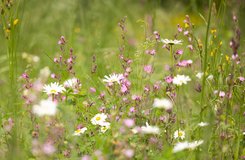To each Max Planck Institute its own biotope
The Biodiversum at the Max Planck Institute for Biophysical Chemistry is a flagship project for more biodiversity
"Every community its biotope" - that is the motto of Peter Berthold, emeritus director at the Max Planck Institute for Ornithology in Radolfzell. In view of the dramatic decline of insects, birds and many other animal groups in Germany, Berthold, together with the Heinz Sielmann Foundation, has shown with the Lake Constance Biotope Network how a network of biotopes can stop species extinction. At the Max Planck Institute for Biophysical Chemistry in Göttingen, the staff have adopted the motto and created the "BioDiversum" on the institute's premises. With over a dozen projects, they are setting an example for biodiversity. The BioDiversum will be officially inaugurated on 18 October 2021.

“In Germany, there are not only communities but also Max Planck Institutes – so why not change the motto to “To each MPI its own biotope?” thought Herbert Jäckle after one of Berthold’s lectures at Göttinger Literaturherbst 2018. The emeritus Director at the MPI for Biophysical Chemistry and former Vice President of the Max Planck Society thus set the ball rolling for a comprehensive redesign of the Institute’s grounds in the interests of nature conservation. “And as befits a Max Planck Institute, we are providing scientific support for the project. To help us monitor the success of our measures, experts recorded all bat, bird, insect, and plant species around the Institute before construction began and will continue to do this for us over the next few years”, says Jäckle.
After two and a half years of construction, the BioDiversum is nearly complete. Around 1.65 hectares (about the area of 1.5 football fields) of monotonous lawns were transformed into meadows and rough grasslands with native wild plants, more than 80 nesting boxes were hung, a year-round feeding station for birds was set up, bat boxes were installed, and a 900 square metre pond was built. The last major measure will be the planting of a meadow orchard in autumn.
The first successes were not long in coming. “What used to be monotonous green lawns is now a field of colourful blossoms. After only a short time, I have already identified over 100 different insect species”, says Alexandre Webster, a postdoctoral researcher in the Meiosis Department at the Institute. The molecular biologist observes and photographs insects in his spare time. Other employees were able to watch live in their offices as a pair of kestrels raised four young in a nesting box made by the Institute’s own carpentry workshop.
"What used to be monotonous green lawn is now a field of colourful blossoms"

But not only animals and plants benefit from the new habitats. The project also enriches the life of the Institute itself. “It’s fascinating how many employees are involved in the BioDiversum. There are now working groups for the maintenance of the nesting boxes, flowering meadows, and the pond as well as a photo and video group. Nature and species conservation has thus become an important identification factor for the Institute after only a short time”, says Carmen Rotte, press officer at the Institute and head of the BioDiversum. The people in charge also attached great importance to making nature tangible through the BioDiversum. “For example, we will involve the Institute’s kindergarten in our own projects. We also want to cooperate with Göttingen schools within the framework of project weeks or subject-specific work”, adds Frederik Köpper, PR officer and coordinator of the project.
"Even small measures for more biodiversity can be implemented by almost every Institute"
Can something comparable be implemented at other Max Planck Institutes as well? Unfortunately, not every MPI is as conveniently located on the outskirts of the city (like the one in Göttingen) or has such a large site with plenty of undeveloped land. “It doesn't have to be a BioDiversum – it can also be a bit smaller. Even small measures such as near-natural green spaces, nesting boxes, protection against bird strikes, and green façades for more biodiversity can be implemented by almost every Institute”, explains Berthold. You can see how this works in Martinsried, Tübingen, and Freiburg. Around the Max Planck Institute of Neurobiology and the MPI of Biochemistry, green spaces have been converted into meadows, and a fire-fighting pond is now a habitat for amphibians. At the Max Planck Institute for Developmental Biology, employees help tend a meadow orchard. And at the Max Planck Institute for the Study of Crime, Security and Law, a green roof creates space for more biodiversity.













